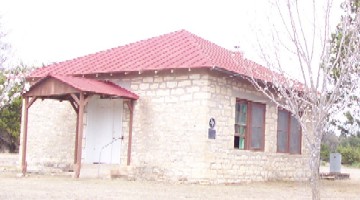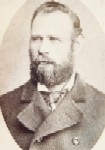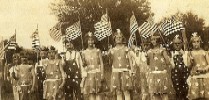|
The Grapetown Community began in
1857 when Ferdinand Doebbler built a stagecoach stop at the crossing
of lower Immigrant Road and upper South Grape Creek. As the community grew,
there became a need for a community school. The Grapetown school was
established in 1859 and served the children of the Grapetown Community
until 1944.
Frederick William Doebbler donated a house used for the first school and
classes began in 1859 with Mr. Louis Hartwig as teacher. Classes were
suspended at the onset of the Civil War. After the war, classes resumed
in a log building. This second school was about a quarter mile northeast
of the first school.
In 1882 Friedrich Baag deeded a parcel of land for which the school trustees
were obligated to build a school with the provision that no religious or
political meetings be conducted there.
 In April 1882 the construction of the current stone building was started.
Since it was constructed by men of the community as time permitted, it took
2.5 years to complete. A large, wood-burning, cast iron stove heated the
schoolhouse. There were double desks for the pupils and a homemade table
for the teacher's desk with a nice armchair of the popular saloon type. A
small brass hand bell called the children in. There was a cupboard to
store the teacher's books and papers. On either side of the door on the wall
were hooks to hang coats and hats, one side for girls, the other side for
boys. A low square table held lunch buckets. A well was drilled for drinking
water. When the well was condemned because of the bad taste of the water,
children carried water from a neighboring farm - about the distance of a city
block.
In April 1882 the construction of the current stone building was started.
Since it was constructed by men of the community as time permitted, it took
2.5 years to complete. A large, wood-burning, cast iron stove heated the
schoolhouse. There were double desks for the pupils and a homemade table
for the teacher's desk with a nice armchair of the popular saloon type. A
small brass hand bell called the children in. There was a cupboard to
store the teacher's books and papers. On either side of the door on the wall
were hooks to hang coats and hats, one side for girls, the other side for
boys. A low square table held lunch buckets. A well was drilled for drinking
water. When the well was condemned because of the bad taste of the water,
children carried water from a neighboring farm - about the distance of a city
block.
 In 1886 it was decided there was a need to provide housing for the teachers and
their families. A small parcel of land adjoining the school grounds was
purchased for $30. A two-room stone dwelling with a porch was completed in 1887.
Mr. Eduard Schmidt (shown at right [1] )
and family were the first residents. Later a breezeway,
kitchen, and storeroom were added on the north side of the house. The
addition was constructed of wood.
In 1886 it was decided there was a need to provide housing for the teachers and
their families. A small parcel of land adjoining the school grounds was
purchased for $30. A two-room stone dwelling with a porch was completed in 1887.
Mr. Eduard Schmidt (shown at right [1] )
and family were the first residents. Later a breezeway,
kitchen, and storeroom were added on the north side of the house. The
addition was constructed of wood.
Children from as far away as seven miles into Kendall County attended the
Grapetown School. They came on horseback and by buggy, and some walked many
miles in all weather conditions.
From Grapetown the distance to Meusebach School was about 5 miles; to Cain City
School about 3.5 miles. On Friday afternoons in the spring, Grapetown School
would alternate ball games with these schools.
 End of the school year festivities were important events in the community.
Public oral briefings were held, often with parents doing the questioning.
In the afternoon, the children's program was held, including skits, drills,
plays and poems. Young children who would start school the following year
were included. In the evening young adults of the community presented plays
in English and German.
End of the school year festivities were important events in the community.
Public oral briefings were held, often with parents doing the questioning.
In the afternoon, the children's program was held, including skits, drills,
plays and poems. Young children who would start school the following year
were included. In the evening young adults of the community presented plays
in English and German.
In 1927 the schoolhouse was enlarged by extending the south wall by about
six feet, making the schoolhouse a square building. In 1944, the eleven
pupils of Grapetown were transported to the Cain City School. In 1949 the
Grapetown School consolidated with the Rocky Hill School District. At the
time of consolidation, the Grapetown school property was transferred to the
Rocky Hill School District.
In 1950, residents of the Grapetown community joined together and formed the
Grapetown Community Club. They purchased the old school property from the
Rocky Hill School District. In 1984, the Grapetown School became a
Texas Historic
Landmark. The members of the Community Club gather once a
month to enjoy an evening of "42", food, and fellowship. Meetings are held
at the school on the 3rd Friday of each month from January through November.
The Grapetown Community Club has taken on the responsibility of caring for
and restoring the school and teacherage. In December a Christmas party is
held for the Grapetown School students, their descendants and current
members of the community.
[1]
Photo of Eduard Schmidt is courtesy of Cypress Creek Community Center.
|